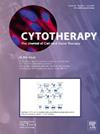在自动化平台上开发自体人类iPSC衍生的协议和机器学习算法,以实现临床半自主制造
IF 3.7
3区 医学
Q2 BIOTECHNOLOGY & APPLIED MICROBIOLOGY
引用次数: 0
摘要
背景,AimA机器人平台和控制算法正在开发用于临床应用的可重复制造的自体诱导多能干细胞(iPSC)衍生细胞疗法,从帕金森病的多巴胺能神经元前体细胞开始。与同种异体疗法不同,自体疗法将排斥反应的风险降至最低,并消除了免疫抑制的需要。目前的制造技术和仪器不适合生产用于细胞治疗应用的自体iPSCs。在这里,我们报告了一个可重复的自动化工作流程和过程控制算法的建立,利用机器人平台产生克隆iPSC培养物,可与手动导出的克隆iPSC培养物相媲美。方法采用非整合方法对来自三种不同供体的成纤维细胞进行重编程,并在机器人平台上培养。对新出现的iPSC菌落周围残留的成纤维细胞进行自动除草,然后进行自动阳性选择并转移到新的培养容器中。该平台还实现了克隆衍生iPSC系的自动进料和传代。结果通过流式细胞术检测,自动生成的iPSC具有较高的活力和表达多能细胞身份标记Tra1-81和Oct3/4,与人工生成的iPSC对照培养相当。深度学习模型从干细胞专家捕获和注释的图像中进行训练,然后集成到自主指导关键流程决策中,实现半自主操作(图1-3)。结论iPSC的自动化生成过程为临床自体iPSC的半自主并行生产奠定了基础。这种方法提高了吞吐量,确保了更好的可追溯性,并通过减少人工操作员在技能、判断和疲劳方面的可变性来提高批次间的一致性。本文章由计算机程序翻译,如有差异,请以英文原文为准。
Development of a Protocol and Machine Learning Algorithms for the Derivation of Autologous Human iPSC on an Automated Platform to Enable Clinical Semi-autonomous Manufacturing
Background & Aim
A robotics platform and control algorithms to enable reproducible manufacture of autologous induced pluripotent stem cell (iPSC) derived cell therapies is in development for intended clinical application, starting with dopaminergic neuron precursor cells for Parkinson's disease. Unlike allogeneic therapies, autologous therapies minimize the risk of rejection and eliminate the need for immune suppression. Current manufacturing technologies and instruments are unsuitable for production of autologous iPSCs for use in cell therapy applications. Here we report establishment of a repeatable automated workflow and in process control algorithms leveraging a robotics platform to produce clonal iPSC cultures comparable to those derived manually.
Methodology
Fibroblasts from three different donors were reprogrammed using a non-integrating method and cultured on the robotics platform. Automated weeding of residual fibroblasts around emerging iPSC colonies was performed, followed by automated positive selection and transfer to a new culture vessel. The platform also conducted automated feeding and passaging of the clonally derived iPSC lines.
Results
The iPSCs generated via the automated process showed high viability and expression of pluripotent cell identity markers Tra1-81 and Oct3/4 by flow cytometry and were comparable to manually derived control iPSC cultures. Deep learning models were trained from images captured and annotated by stem cell experts and later integrated to autonomously guide key process decisions, enabling semi-autonomous operation (Figures 1-3).
Conclusion
The automated iPSC generation process establishes a foundation for a semi-autonomous parallel process of autologous clinical iPSC production. This approach enhances throughput, ensures better traceability, and improves lot-to-lot consistency by mitigating human operator variability with respect to skill, judgement, and fatigue.
求助全文
通过发布文献求助,成功后即可免费获取论文全文。
去求助
来源期刊

Cytotherapy
医学-生物工程与应用微生物
CiteScore
6.30
自引率
4.40%
发文量
683
审稿时长
49 days
期刊介绍:
The journal brings readers the latest developments in the fast moving field of cellular therapy in man. This includes cell therapy for cancer, immune disorders, inherited diseases, tissue repair and regenerative medicine. The journal covers the science, translational development and treatment with variety of cell types including hematopoietic stem cells, immune cells (dendritic cells, NK, cells, T cells, antigen presenting cells) mesenchymal stromal cells, adipose cells, nerve, muscle, vascular and endothelial cells, and induced pluripotential stem cells. We also welcome manuscripts on subcellular derivatives such as exosomes. A specific focus is on translational research that brings cell therapy to the clinic. Cytotherapy publishes original papers, reviews, position papers editorials, commentaries and letters to the editor. We welcome "Protocols in Cytotherapy" bringing standard operating procedure for production specific cell types for clinical use within the reach of the readership.
 求助内容:
求助内容: 应助结果提醒方式:
应助结果提醒方式:


